The world works in weird ways. Last week I received two dumpling questions from people whose names started with the letters D and A. Go figure. Dao and Dave posed great questions about how to efficiently make dumplings. I’ve spent countless hours making dumplings and maintain a stash of dumplings in my frozen food bank (a stand-up freezer in the garage). Part of the answer to practice and eat a lot of dumplings. But as you do that, you can proceed in a smart manner so that your learning curve isn’t super steep. I’ve made many mistakes so you don’t have to.
I’m sharing Dao and Dave’s questions and my responses. Weigh in with questions and/or suggestions.
Dao wrote:
I recently started making my own dumplings using your Asian dumpling book. I have a couple of questions if you have time to respond.
1. How do you keep the dumplings from drying out as you are working on them? I lay my finished ones out on a tray and cover it with a tea towel but find that they dry out quick.
2. Also what is your workflow for shaping and wrapping the dumplings? I've been just pressing/shaping them one at a time and then wrapping. It takes quite a bit of time as you know. Is there a good tip to do it more assembly line style? Like shape them all first and them wrap? Or will this dry out?
I like to make dumplings in batches -- say 8 or 16 at a time. That's ¼ or ½ of a batch of the basic dumpling dough. It depends on how comfortable you are with rolling out wrappers. If you’re working alone and are new to it, work in smaller batches. If friends are around to help, go with half batch. It also depends on the dough. Some days, if it’s super moist, it may benefit from airing out a bit.
Instead of a tea towel, try plastic wrap to cover the finished dumplings. Always keep unused dough in the plastic bag. A one-by-one approach to making dumplings slows things down just a bit between each one. That slowdown adds up and likely lead to the drying out.
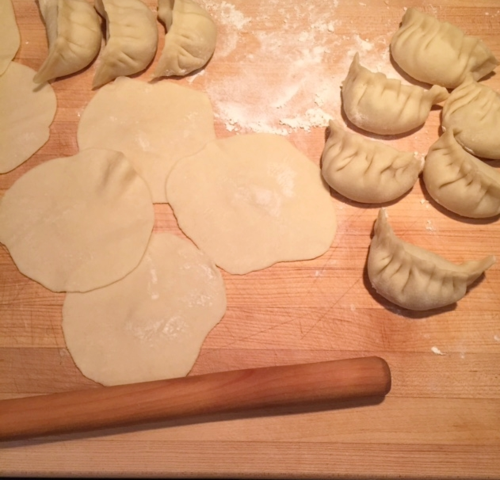
If it's dry where you live or if you have a super strong exhaust system that runs in the kitchen, the air may cause dryness. I once make dumplings in a corporate research and development kitchen that had an incredible exhaust system. You never smelled anything cooking! Unfortunately, I had to protect every dumpling we made by cover them with a dish towel as we worked. When a baking sheet was filled (we made dumplings for 50 people), I covered it with plastic wrap or cooked it off.
On the other hand, dumpling dryness may be dealt with during the cooking process, so long as the wrappers didn’t crack so that there are tears. For example, if you boil or panfry the dumplings, the water used for cooking will hydrate the skin. With a steamer, you’ll have better luck with a metal steamer which retains more moist heat inside the steamer than bamboo steamer trays.
Dave emailed:
I ordered your book this week and am really enjoying it! I've been inspired to dive deeper into dumplings by my friend and recent Top Chef runner up Gregory Gourdet (he has a very good and simple dumpling recipe online!).
Anyway...I have a question regarding freezing. In some recipes you advise freezing the cooked dumplings. Is it also ok to freeze some uncooked dumplings? What are the rules here? The online debate goes both ways so I'm curious what your deeper thoughts are. LMK and thank you for a great book!
Indeed, the recipes in the Asian Dumplings cookbook include lots of make ahead and storage tips. Is there a set of unifying rules to freezing dumplings?
It all depends on the wrapper/skin – what freezes well frozen and what freezers better cooked. For example, dumplings encased in the basic dumpling dough freeze well uncooked. Same thing for thin skins like wontons, siu mai and egg and spring rolls.
Leavened bao dough, on the other hand, freeze better after they've been steamed. If you froze them raw, the thawing and steaming process may not turn out well due to moisture collecting. You’re best off cooking them in advance. Wheat starch dough for dim sum like har gow can dry easily. Plus, as a newly-gluten-less dough, wheat starch has no give in its raw state. Steaming activates the elasticity in the dough – important for freezing and thawing, as things contract and expand. Given that, I found that cooking dumplings made with wheat starch and then freezing them works best.
You’d think that dough is dough but it’s not. Each type has its performance quirks and personality and we have to respect that in Asian dumplings.
If you have insights to share, please do!













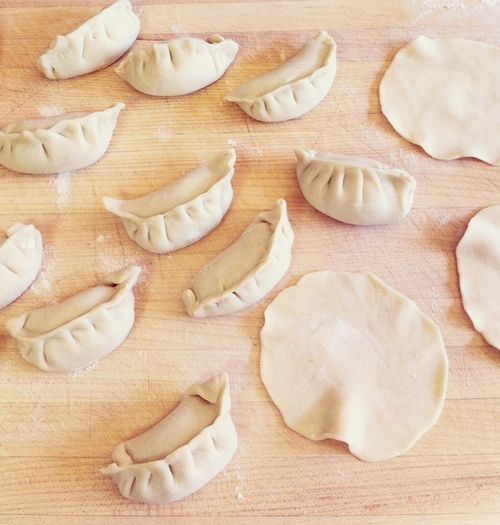
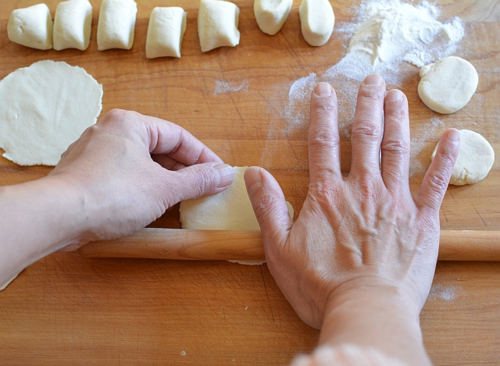
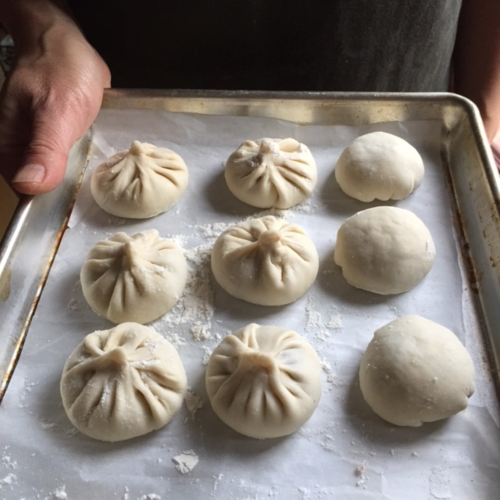
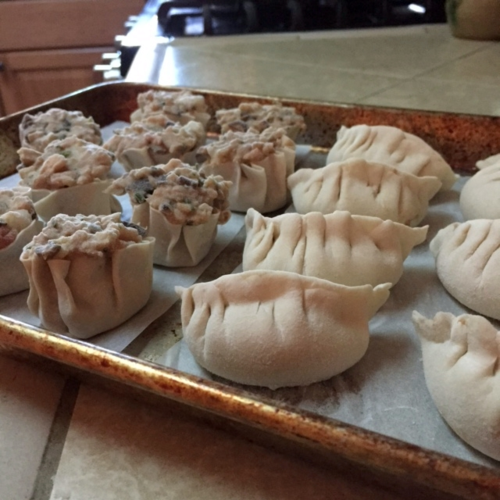




Michelle says
I have already marinated dumpling filling in the freezer. Can I thaw, prep the dumplings, and freeze again?
Andrea Nguyen says
You can try but I don't know what would happen. It's all about the moisture level. Try and see! Let know how it works. I've never done it so please share your experience!
Andrea says
Hello Andrea!
I was wondering if you can freeze or refrigerate homemade dumplings wrappers that have already been rolled out....
I suppose it would be like the ones you purchase at the store? Or would these stick together more easily?
Andrea Nguyen says
Hi Andrea!!! Nice name. 😉 I freeze dumplings that have already been filled and shaped BUT not cooked. The skins will stick because they are a lot more moist than ones at the store. Purchased wrappers are drier and coated with lots of flour and/or starch. If you roll out your own dough, fill and shape then freeze. Then there's little work but to thaw, cook and eat.
Netta says
Hi Andrea,
I Wonder if you have any suggestions about thawing frozen dumplings so I can pan-fry them? I'm worried about the moisture that will form on their surface that can make a good pan-frying difficult. Thanks!
Andrea Nguyen says
Partially thaw them, dip their butts in a little flour and then pan-fry them. There should not be any ice on the dumplings if they are individually quick frozen properly. If there's ice, knock it off before you thaw. Experiment. I am advising you based on my experience with certain homemade doughs and purchased wrappers.
Christina says
Hi Andrea:
I made two batches of your recipe and got tired after doing 1 batch so wanted to know if it's possible to freeze the basic dumpling dough. If yes, any particular instruction later on for thawing and rolling? Thanks
Andrea Nguyen says
It's so easy to whip up a batch of the dumpling dough that I've never frozen it before. You could certainly try and see what happens. If it doesn't work well, then make a quickie batch of dough on the spot. Never hurts to experimen like this. Thanks for going the DIY dumpling route.
Paul says
Hello!
I hope you can help..Is it ok to shape the filling into the individual dumpling sized portions and freeze - and then roll out the wrappers and stuff them with the filling frozen? I find working with wet filling tricky when trying to seal the dumplings.
I hope that makes sense - any advice would be fantastic.
Thank you.
Andrea Nguyen says
I don't know. I think you can do that. You can shape the dumplings with two spoons and compact them then partially freeze them as lumps on a baking sheet lined with parchment. Freeze them for like 15 minutes. Then, fill and shape. Let me know how that works!
Tej says
Hi,
I’be recently become a keen dumpling maker and eater! And started to make my own crystal skins, I always make too many, I was wondering if theses freeze well when cooked, or if I should freeze them raw?
Thanks
Andrea Nguyen says
I've never frozen the skins unfilled. They're not the same as commercially made wonton or pot sticker wrappers. The wheat starch dough is so easy to make that you can just whip it up and use it. I know it's a waste but you can make a bigger batch and enjoy lots of dumplings!